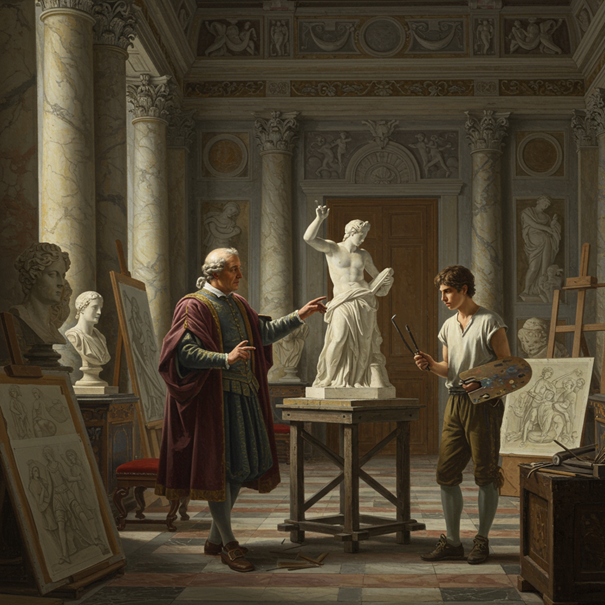Sfumato's Embrace: The Gentle Art of Leonardo da Vinci's Mysteries
- Lavinia de Leonis

- Jul 22
- 4 min read

I fervently embrace the belief that art transcends mere visual delight—it is a profound bridge to our history, our emotions, and the very essence of humanity. Among the myriad techniques that have graced the artist's palette, few hold the captivating allure and subtle power of Sfumato, the signature of a genius whose name echoes through the centuries: Leonardo da Vinci. This gentle art, a whispered secret woven into the very fabric of his masterpieces, invites us to gaze upon a world where light and shadow dance in an ethereal haze, conjuring mystery and revealing the deepest recesses of the soul. Today, with a heart full of passion, I wish to unveil the very essence of this captivating technique, inviting you on a journey through canvases where the boundaries of form dissolve, illuminating human experience in ways few other artistic inventions ever could.
What is Sfumato? Defining the Ethereal Haze
The term itself, "Sfumato," whispers from the heart of Italy, derived from "sfumare," meaning "to soften" or "to evaporate like smoke." But it is far more than a simple description of a smoky effect. It is the meticulous and painstaking blending of colors and tones, creating imperceptible transitions between areas of light and shadow within a single composition, utterly eliminating harsh outlines and abrupt shifts. Unlike paintings where light might be evenly distributed or sharply delineated, Sfumato artists, and Leonardo da Vinci above all, achieved a soft, hazy, almost dreamlike quality that blurs contours, making forms emerge gently from the background and receding into atmospheric depth. This technique is not merely about replicating natural light; it is about orchestrating it with an almost spiritual delicacy, guiding your eye through a scene that feels both real and profoundly elusive, inviting a deeper, more contemplative gaze.
Leonardo's Masterpieces: Where Sfumato Breathes Life
To truly grasp the magic of Sfumato, we must turn to the incandescent canvases where Leonardo wielded it like a sorcerer conjuring mist, each stroke a testament to his unique vision and profound impact. Think, of course, of the Mona Lisa, her iconic, enigmatic smile forever captivating. It is Sfumato that makes her expression seem to shift, to hold a secret just beyond our grasp. The soft, elusive quality of her gaze, the subtle play of light and shadow around her lips and eyes, and the atmospheric, hazy landscape behind her—all are products of this masterful blending, making her feel eternally alive, yet perpetually mysterious. Then consider The Virgin of the Rocks, where Sfumato wraps the figures of Mary, the Christ Child, John the Baptist, and the angel in a unifying, soft light within a mysterious grotto. The gentle gradations of tone create an otherworldly and intimate atmosphere, as if divine light itself is filtering through the humid air. And in Saint John the Baptist, the figure emerges from the deep shadows with a subtle, almost glowing quality, his enigmatic smile and gesture emphasized by the gentle, seamless transitions of light across his form. In each instance, Sfumato does not just render form; it imbues it with a profound sense of life, thought, and elusive truth.
The Psychological and Emotional Resonance of Sfumato
The enduring power of Sfumato lies in its timeless appeal, speaking to the complexities of human perception and emotion. The blurring of lines and the absence of stark definition in Leonardo's work mirror the inherent ambiguity of human experience, thought, and the very nature of reality. It is a technique that demands active engagement from the viewer, inviting us to lean in, to ponder, to fill in the "missing" details with our own interpretation, making the experience deeply personal and endlessly fascinating. Leonardo, ever the scientist, understood how light scatters through the atmosphere, how mist softens distant forms, and he translated this keen observation of the natural world into a visual language that perfectly captured the elusive, internal life of his subjects.
Sfumato's Enduring Whisper: Beyond Leonardo
Moreover, the influence of Sfumato extends far beyond the canvas of the Renaissance. Its principles of subtle transition and atmospheric depth continue to resonate in various visual arts, from the nuanced lighting of classical photography to the ethereal atmospheres of modern cinema. The magic born in Leonardo's studio continues to shape the visual stories we consume today, a testament to its profound and timeless appeal. I urge you, my dear readers, to seek out these magnificent works in museums, online galleries, or even in the quiet corners of art books. Allow your eyes to linger on the subtle dance of light and dark, and experience the profound, gentle embrace of Sfumato firsthand.
Conclusion: The Enduring Glow of the Masters
Sfumato is far more than a technical term; it is a profound language spoken by light and shadow, allowing artists to delve into the very depths of human existence. Through his unparalleled control of illumination, Leonardo da Vinci didn't merely paint subjects; he illuminated the very soul of humanity, capturing the elusive nature of reality and the subtle dance of existence. He created timeless works that continue to inspire awe, provoke introspection, and remind us of the boundless capacity of art to reveal what lies beneath the surface.
So, the next time you encounter a painting by the master, pause. Look closely at the way the light falls, at the secrets the shadows hold. You might just find yourself caught in the enduring glow of Leonardo's genius, witnessing the extraordinary way light and darkness combine to tell stories that resonate with the deepest corners of our hearts.

.png)



Comments